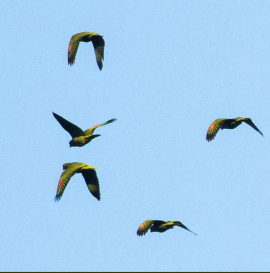Tucumán Amazon |
|
|
Also known as: Alder Parrot (Amazon)
Photos
View in GalleryDid You Know?
Tucumán fledglings are noisy and fearless. One breeder reports that 20 in one flight were so active and boisterous that it was hazardous to enter their enclosure.Academic Research
Related publications: Amazona tucumanaSpecies Profile
Genus: Amazona | Species: tucumana
Size:
31cm (12.1 in)
Weight:
320g (11.2 oz)
Subspecies including nominate:
one
Colour Adult:
Both adults mainly green, largish parrots; stocky, with short tail. Red forehead, forecrown and on upperwings; body feathers scalloped with black; orange thighs; tail green with red at base. Bill pink/tan. Eye orange/red.
Colour Juvenile:
As in adult but with minimal red on forehead, followed by orange in some individuals; primary coverts and thighs green. Eye grey.
Call:
Mainly shrieking.
Listen NowMore Information:
Content Sources:
CITES
BirdLife International
Cornell Lab of Ornithology/Birds of the World
A Guide to Parrots of the World, Juniper and Parr, 1998
ML Media Collection Catalogue 129095, Tucuman Parrot Amazona tucumana, Andersen, Michael, Jujuy, Argentina, Oct. 22 2005, Cornell Lab of Ornithology. Site
Parrots of the World, Forshaw and Cooper, 1989.
L. Rivera, 2004
Genus Amazona, Stoodley and Stoodley, 1990.
Article, "Tucuman Amazon," by Susan Clubb, DVM
Parrots of the World, Forshaw, 2006.
Parrots in Aviculture, Low, 1992.
Photos
View in GalleryDid You Know?
Tucumán fledglings are noisy and fearless. One breeder reports that 20 in one flight were so active and boisterous that it was hazardous to enter their enclosure.Academic Research
Related publications: Amazona tucumanaSpecies Care
Captive Status:
Limited number in captivity.
Longevity:
Up to 50 yrs.
Housing:
Aviary or suspended enclosure, minimum length 3m (9.8 ft).
Diet:
Fruit such as: apple, pear, orange, banana, cactus fruits, pomegranate, forming about 30 % of the diet; fresh vegetables such as: carrot, celery, green peas, beans, fresh corn, green leaves; spray millet and limited mixed seed, cooked beans and pulses, complete kibble.
Enrichment:
Are chewers, so provide safe wood (fir, pine, willow and elder) and vegetable tanned leather toys, foraging/puzzle toys; ladders, swings, ropes and different sized perches. Also enjoys bathing so provide overhead misters or shallow water bowls.
Nest Box Size:
12" x 12" x 24" (30.5cm x 30.5cm x 61cm) vertical box.
Clutch Size:
3 to 4
Incubation Time:
27 days
Fledging Age:
8 to 9 weeks
Hatch Weight:
9-10g (0.3-0.35 oz)
Peak Weight:
314g (11 oz)
Weaning Weight:
252g (8.8 oz)
Photos
View in GalleryDid You Know?
Tucumán fledglings are noisy and fearless. One breeder reports that 20 in one flight were so active and boisterous that it was hazardous to enter their enclosure.Academic Research
Related publications: Amazona tucumanaSpecies Wild Status
World Population:
10,000-20,000
IUCN Red List Status:
Vulnerable
CITES Listing:
Appendix I
Threat Summary:
A BirdLife 'restricted range' species. Affected by habitat loss and local trapping for wild bird trade.
Range:
Occurs in SE Bolivia, in Chuquisaca and Tarija, and NW Argentina, in Jujuy, Salta, Tucuman and Catamarca.
Habitat:
In montane forest with
Wild Diet:
Feeds on Podocarpus parlatorei, Blepharocalyx salicifolius, Myrcianthes mato, Acacia visco, Cinnamomun porphyria, Juglans australis and Cedrela lilloi, as well as fruits and seeds of Podocarpus, Blepharocalyx, Myrcianthes and leguminous trees as Acacia. Also taken are the flowers of Juglans australis and flowers and fruits of exotic species such as Morus alba, Mespilus germanica and Ligustrum lucidum.
Ecology and Behaviour:
Can occur in very large groups (up to 10,000 birds or more, the entire population of an area) but generally in flocks from a few to over 200 individuals.
Clutch and Egg Size:
3 to 4 rounded eggs, 34.5 x 26.5mm (1.3 x 1 in).
Breeding Season:
November-January; nest is in large trunks of Blepharocalyx, Podocarpus, Alnus, Ilex argentina and other tree species, often originally excavated by Cream-backed Woodpeckers (Campephilus leucopogon).
Related Links:
Photos
View in GalleryDid You Know?
Tucumán fledglings are noisy and fearless. One breeder reports that 20 in one flight were so active and boisterous that it was hazardous to enter their enclosure.Academic Research
Related publications: Amazona tucumanaMembers Only Resources
Please log-in now to find more research, resources and tools.
Not a Member?
Find more great information:
Gain exclusive access to 600+ pages of additional research, seminars and podcasts, specialists to ask your toughest questions, and dozens of other fun resources - when you become a WPT member.
Join Today >>

































